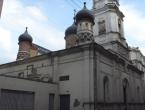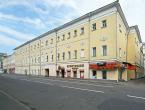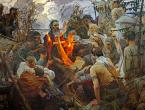Ascribed temples. Affiliated churches Temple of St. Nicholas the Wonderworker red ringing schedule
The Church of St. Nicholas the Wonderworker “Red Bell” has always seemed to me one of the most forgotten churches in Kitay-Gorod. Probably undeservedly forgotten, because a lot of interesting things are connected with it.
The temple is located on Nikolsky Lane, connecting Ilyinka and Varvarka. In the 17th century, this lane was called Posolskaya Street after the Ambassadorial Courtyard located there. Later, the lane was called Yushkov after the Yushkov estate, also known since the 17th century, and from 1928 to 1992 - Vladimirov Passage (in honor of M.K. Sheinfinkel-Vladimirov, deputy chairman of the Supreme Economic Council).
The stone church on this site has been known since the second half of the 16th century. There is a legend that Metropolitan Philip himself founded it, but the version that the St. Nicholas Church was built at the expense of the Chinatown merchant Grigory Tverdikov seems more realistic to researchers.
The temple was rebuilt several times. The current building was built in 1858 through the efforts of the merchant Polyakov. Among the possible architects is the famous Nikolai Ilyich Kozlovsky, who at least worked on the iconostasis.

The icon of Hodegetria, painted by Simon Ushakov, was also kept in the temple. I wonder what her fate will be?
The temple is also known for the eerie story of how relatives buried in it (or in the cemetery next to it) the head of the head of the Konyushenny Prikaz, Alexei Sokovnin, who participated in a conspiracy by supporters of Princess Sophia and was executed by order of Peter. The body was never given to them.
Well, the main feature of the Church of St. Nicholas “Red Ring” is associated with its bells. Hence the name, since the “red ringing” is a beautiful ringing. The beauty of the ringing of the bells of the Church of St. Nicholas “Red Ring” was noted by many. True, it is also worth noting the unsubstantiated legend that the temple bells were painted red.
There was also one captive bell, cast in the 15th century and taken under Alexei Mikhailovich during the war with Poland. On the bell there were three lilies and an inscription, which is now interpreted as follows: “All hope lies in the bell from Chene in France.” After the temple was closed in 1927, this bell was transferred to Kolomenskoye.
During the Soviet period, the Church of St. Nicholas the Wonderworker “Red Bell” had a hard time. First, the building was seized by the “Free Labor Church” of Ioannikiy Smirnov and the anarchist poet Alexei Svyatogor. Then the idea of demolition arose, which, fortunately, did not come to fruition.

The temple was handed over to some institution, and in 1967 a power plant was built in it, for which the windows were covered with bricks and the room was concreted. Later, a building was attached closely to the church from the north and together with it it was included in the complex of new buildings of the CPSU Central Committee.
Now the temple is being restored, but it looks very sad and depressing. And this is how he looked before the revolution in a photograph from Naydenov’s album: 
Patriarchal metochion in Kitai-Gorod, Moscow.
Address: 103012, Moscow, Nikolsky per., 9a, building 1.
Phone: (495) 606–62–45
Working hours
The temple is open during services.
Metro station "Kitay-Gorod" (Kaluzhsko-Rizhskaya or Tagansko-Krasnopresnenskaya lines), exit to the city "on Kitaigorodsky proezd, Varvarka street and Old Square." Near the exit from the metro, Varvarka Street begins - follow it to Nikolsky Lane, it will be the second on the right side if you walk from the metro towards the Kremlin. Turn right into Nikolsky Lane. 
Divine services
On Fridays at 9:00 - Matins, Divine Liturgy.
Thrones
Nativity of the Blessed Virgin Mary (main chapel); Saints Reverend Zosima and Savvaty of Solovetsky.
Patronal holidays:
Feast of the Nativity of the Blessed Virgin Mary - September 21 (main patronal feast day);
Memorial Day of Saints Zosima and Savvaty of Solovetsky is April 30.
Story The Church of St. Nicholas the Wonderworker “Red Bell” is located in one of the oldest historical districts of Moscow - in Kitai-Gorod, on Yushkov Proezd (later Vladimirov Proezd, since 1992 Nikolsky Lane), connecting Varvarka and Ilyinka streets. The temple is known from chronicles from the 16th century.
The Church of St. Nicholas the Wonderworker “Red Bell” is located in one of the oldest historical districts of Moscow - in Kitai-Gorod, on Yushkov Proezd (later Vladimirov Proezd, since 1992 Nikolsky Lane), connecting Varvarka and Ilyinka streets. The temple is known from chronicles from the 16th century.
The temple received its name - “Red Ringing” - from the unusually beautiful ringing of its bells.
In 1858, the old church and its premises were dismantled and the current temple was built in their place by the merchant Polyakov.
In the 17th century, the church was designated as follows: “what is known at the Red Bell Towers on Posolskaya Street,” which was named after the Ambassadorial Courtyard - a complex of buildings located on the corner with Ilyinka.
The main altar of the Nativity of the Virgin Mary was built in the old church by S. G. Naryshkin no earlier than 1705. Nikolsky chapel from the south, northern chapel in the name of Zosima and Savvaty Solovetsky.
At the end of 1922, the temple was seized by the “Free Labor Church” of Fr. Ioannikiy Smirnov and the anarchist poet Alexei Svyatogor “For non-compliance with the contract, the contract with believers for the Church of St. Nicholas the Red Bell in Yushkov Lane near Ilyinka was terminated. The temple was transferred to another group of believers who wanted to take it” (1923–1924).
In 1925, the temple was scheduled for demolition, but it was only by a miracle that it was not demolished. The temple was closed around 1927.
In 1964, the church was renovated. It housed an institution. In 1967, it was released from the institution, the windows were bricked up, the room was concreted and a power plant was installed in it. Later, a building was attached closely to the church from the north and together with it it was included in the complex of new buildings of the CPSU Central Committee.
By 1990, the domes on the chapters were rusted - in some places through and through. Crosses remained only on the central chapter and the bell tower, on the four side chapters there were only pins.
By decision of the Moscow City Council dated July 25, 1991, the temple was returned to believers. On December 19, 1996, the temple was re-consecrated.
In recent years, repair and restoration work has been carried out in the temple. The interior, completely destroyed during the hard years, has been recreated. The ringing tier of the bell tower was put into operation, for which 7 new bells cast in the Urals were purchased in 2001.
Regular services have been resumed in the central part of the church (throne in the name of the Nativity of the Virgin Mary). In the chapel of Zosima and Savvaty Solovetsky the sacrament of Baptism is performed.
Shrines
Temple icon of St. Nicholas the Wonderworker (19th century), revered icon of the Mother of God of Czestochowa, revered icon of the new martyr of the Russian Hieromartyr Konstantin Bogorodsky.
The nickname of this church is unique for Moscow: the name “Red Bell” is not found anywhere else. These words are all that today reminds us of one of the most beautiful bell ringings in Moscow.
As a rule, the initial temple buildings were built of wood, and then erected in stone. In the case of the Church of St. Nicholas the Wonderworker “Red Bell”, first mentioned in 1561, it was immediately a question of a stone building, which is rare for Moscow. The builder of the temple was the merchant Grigory Tverdikov. Already in the 16th century, the name “Nicholas the Red Ring” appeared, denoting the special beauty of the church’s bell ringing. Subsequently, her bell selection continued to be replenished. Thus, in the middle of the 17th century, a bell made in 1573 with foreign inscriptions and an image of three lilies was donated to the church - a trophy in the Russian-Polish war for Ukraine. The attention of the authorities to the St. Nicholas Church is also evidenced by the transfer to it in the same years of an iconostasis created by Ukrainian masters and icons by the famous icon painter Simon Ushakov.
An image of the old St. Nicholas Church has been preserved: a stone quadrangle covered with an octagonal roof with one dome, walls with slit-like windows, and a powerful octagonal bell tower adjoining the west. Despite its antiquity, in 1858 this building was demolished for the construction of a new church. The funds for the work were allocated by the merchant Polyakov, the design of the church and its interiors was developed by architects A.M. Shestakov and N.I. Kozlovsky. The temple was built in the pseudo-Russian style, which had not yet reached its peak in the 1850s. Therefore, its facades are decorated very modestly, the lower part of the building is completely smoothly plastered, marked only by three arches along the street facade. But the octagonal tented bell tower with two rows of dormer windows, placed above the entrance on the western side, and five onion domes with drums decorated with three rows of small kokoshniks - all these are features of the pseudo-Russian style.
In 1927, services in St. Nicholas Church ceased. Recognized as “low value,” it was scheduled for demolition, but survived. The interior decoration was completely lost. Only the bell of 1573, brought from Poland, was preserved and transferred to the museum in Kolomenskoye. The temple space was divided into several floors and housed various government institutions. In the 1960s, an electrical substation was installed inside.
Later, the church was surrounded on several sides by a new complex of buildings of the CPSU Central Committee, to which the temple building was also assigned. In 1991, the process of transferring the church to the community of believers began, but permanent services were organized only in 1996. For many years the domes remained rusty, there were cracks in the walls, and crosses completed only the bell tower and the central dome. However, restoration work is gradually returning the temple to its historical appearance. Today the four side chapters are again crowned with crosses.
Moscow, Nikolsky per., 9 “a”, metro: “Kitay-Gorod”.
The Church of St. Nicholas the Wonderworker “Red Bell” is located in one of the oldest historical districts of Moscow - in Kitai-Gorod, on Yushkov Proezd (later Vladimirov Proezd, since 1992 Nikolsky Lane), connecting Varvarka and Ilyinka streets. The temple is known from chronicles from the 16th century.
The temple received its name - “Red Ringing” - from the unusually beautiful ringing of its bells. On the bell tower there was a bell from 1573 (or 1473) with an inscription in a foreign language, after the closure of the temple in 1927, it was transferred to the museum of the village of Kolomenskoye.
The church has been built in stone since 1561. It was built by the merchant Grigory Tverdikov. There is a legend that the temple was founded by St. Philip, Metropolitan of Moscow, in memory of the days he spent in the Solovetsky monastery. In 1625 the church was also listed as stone.
It burned down in a fire in 1626 and was renovated.
In 1691, it was again updated, but still continued to retain the character of a 16th-century building. The consecration of the temple in 1691 was performed by the last Patriarch of the pre-Synodal period, Adrian.
On the bell tower there was a bell with the image of three lilies and the letters “ET” with the mark 1575 and an illegible inscription - apparently, it was one of the “captive” bells taken under Tsar Alexei Mikhailovich during the war against Poland for Little Russia and White Russia.
Many historical sources mention the existence of an ancient family cemetery behind the altar of the temple. Among the graves of noble parishioners and investors in the church was buried the head of the quartered rebel boyar A.P. Sokovnin, executed on charges of an attempt on the life of Peter the Great.
In 1858, the old church and its premises were dismantled and the current temple was built in their place by the merchant Polyakov.
In the 17th century, the church was designated as follows: “what is known at the Red Bell Towers on Posolskaya Street,” which was named after the Ambassadorial Courtyard - a complex of buildings located on the corner with Ilyinka.
The architect of the church is definitely unknown. It could have been either A.M. Shestakov, who made construction estimates, or N.I. Kozlovsky, who reliably owned the iconostasis project.
The church was built in the spirit of eclecticism, oriented in the interpretation of some elements to examples of ancient Russian architecture, the church is crowned with a large, widely spaced five-domed dome on drums decorated with kokoshniks. The bell tower is completed with a tent. The slender vertical bell tower once played a significant role in the panorama of Kitay-Gorod.
The main altar of the Nativity of the Virgin Mary was built in the old church by S. G. Naryshkin no earlier than 1705. Nikolsky chapel from the south, northern chapel in the name of Zosima and Savvaty.
During the census of the church property in 1663, among others, a carved gilded iconostasis, made in Kyiv, and an icon of Hodegetria by Simon Ushakov were named.
At the end of 1922, the temple was seized by the “Free Labor Church” of Fr. Ioannikiy Smirnov and the anarchist poet Alexei Svyatogor “For non-compliance with the contract, the contract with believers for the Church of St. Nicholas the Red Bell in Yushkov Lane near Ilyinka was terminated. The temple was transferred to another group of believers who wanted to take it” (1923–1924).
In 1925, the temple was scheduled for demolition, but it was only by a miracle that it was not demolished. The temple was closed around 1927.
In 1964, the church was renovated. It housed an institution. In 1967, it was released from the institution, the windows were bricked up, the room was concreted and a power plant was installed in it. Later, a building was attached closely to the church from the north and together with it it was included in the complex of new buildings of the CPSU Central Committee.
By 1990, the domes on the chapters were rusted - in some places through and through. Crosses remained only on the central chapter and the bell tower, on the four side chapters there were only pins. The temple is not under state protection - it is not on the list of monuments. It is included only in the list of objects proposed for state protection in Moscow, with the dating “1681–1691, 1846, late 19th–20th centuries.” By decision of the Moscow City Council dated July 25, 1991, the temple was returned to believers. On December 19, 1996, the temple was re-consecrated.
In recent years, repair and restoration work has been carried out in the temple. The interior, completely destroyed during the hard years, has been recreated. The ringing tier of the bell tower was put into operation, for which 7 new bells cast in the Urals were purchased in 2001.
Regular services have been resumed in the central part of the church (throne in the name of the Nativity of the Virgin Mary). In the chapel of Zosima and Savvaty Solovetsky the sacrament of Baptism is performed.
In 2001–2003 For the temple, icons of the Mother of God of Czestochowa were painted (they pray to her especially for the salvation of Russia at the present time), icons of the royal martyrs, new martyrs of Russia - Seraphim Chichagov and Konstantin Bogorodsky, holy righteous Anna. The shrine of the temple is the Icon of St. Nicholas the Wonderworker - the only icon that has survived from pre-revolutionary times.




